An SPS-RS Technique for the Fabrication of SrMoO4 Powellite Mineral-like Ceramics for 90Sr Immobilization
Abstract
:1. Introduction
2. Experimental
2.1. Reagents
2.2. Reactive Mixture Preparation
2.3. SPS-RS Fabrication of SrMoO4 Ceramics
2.4. Ceramics Preparation Prior to Characterization
2.5. Characterization Methods
3. Results and Discussion
- Ion sizes should differ by no more than 10–15%. The ionic radius of Ca2+ is 1.04 Å and the ionic radius of Sr2+ is 1.2 Å, resulting in a difference of 14%.
- The difference in electronegativity is less than 0.4. The electronegativity of Ca2+ is 1.00 and that of Sr2+ is 0.95, resulting in a difference of 0.05.
4. Conclusions
Author Contributions
Funding
Institutional Review Board Statement
Data Availability Statement
Conflicts of Interest
References
- Potanina, E.A.; Orlova, A.I.; Mikhailov, D.A.; Nokhrin, A.V.; Chuvil’deev, V.N.; Boldin, M.S.; Sakharov, N.V.; Lantcev; Tokarev, M.G.; Murashov, A.A. Spark Plasma Sintering of Fine-Grained SrWO4 and NaNd(WO4)2 Tungstates Ceramics with the Scheelite Structure for Nuclear Waste Immobilization. J. Alloys Compd. 2019, 774, 182–190. [Google Scholar] [CrossRef]
- Brinkman, K.; Fox, K.; Marra, J.; Reppert, J.; Crum, J.; Tang, M. Single Phase Melt Processed Powellite (Ba,Ca)MoO4 for the Immobilization of Mo-Rich Nuclear Waste. J. Alloys Compd. 2013, 551, 136–142. [Google Scholar] [CrossRef]
- Peterson, J.A.; Crum, J.V.; Riley, B.J.; Asmussen, R.M.; Neeway, J.J. Synthesis and Characterization of Oxyapatite [Ca2Nd8(SiO4)6O2] and Mixed-Alkaline-Earth Powellite [(Ca,Sr,Ba)MoO4] for a Glass-Ceramic Waste Form. J. Nucl. Mater. 2018, 510, 623–634. [Google Scholar] [CrossRef]
- Patel, K.B.; Boizot, B.; Facq, S.P.; Lampronti, G.I.; Peuget, S.; Schuller, S.; Farnan, I. β-Irradiation Effects on the Formation and Stability of CaMoO4 in a Soda Lime Borosilicate Glass Ceramic for Nuclear Waste Storage. Inorg. Chem. 2017, 56, 1558–1573. [Google Scholar] [CrossRef]
- Maltsev, D.A.; Lomachuk, Y.V.; Shakhova, V.M.; Mosyagin, N.S.; Skripnikov, L.V.; Titov, A.V. Compound-Tunable Embedding Potential Method and Its Application to Calcium Niobate Crystal CaNb2O6 with Point Defects Containing Tantalum and Uranium. Phys. Rev. B 2021, 103, 205105. [Google Scholar] [CrossRef]
- Spano, T.L.; Olds, T.A.; Hall, S.M.; Van Gosen, B.S.; Kampf, A.R.; Burns, P.C.; Marty, J. Finchite, Sr(UO2)2(V2O8)·5H2O, a New Uranyl Sorovanadate with the Francevillite Anion Topology. Am. Mineral. 2023, 108, 383–388. [Google Scholar] [CrossRef]
- Banerjee, C.; Dudwadkar, N.; Tripathi, S.C.; Gandhi, P.M.; Grover, V.; Kaushik, C.P.; Tyagi, A.K. Nano-Cerium Vanadate: A Novel Inorganic Ion Exchanger for Removal of Americium and Uranium from Simulated Aqueous Nuclear Waste. J. Hazard. Mater. 2014, 280, 63–70. [Google Scholar] [CrossRef]
- Çiftyürek, E.; Sabolsky, K.; Sabolsky, E.M. Molybdenum and Tungsten Oxide Based Gas Sensors for High Temperature Detection of Environmentally Hazardous Sulfur Species. Sens. Actuators B Chem. 2016, 237, 262–274. [Google Scholar] [CrossRef]
- Liu, F.; Wang, J.; Jiang, L.; You, R.; Wang, Q.; Wang, C.; Lin, Z.; Yang, Z.; He, J.; Liu, A.; et al. Compact and Planar Type Rapid Response Ppb-Level SO2 Sensor Based on Stabilized Zirconia and SrMoO4 Sensing Electrode. Sens. Actuators B Chem. 2020, 307, 127655. [Google Scholar] [CrossRef]
- Tian, X.; Guo, L.; Wen, J.; Zhu, L.; Ji, C.; Huang, Z.; Qiu, H.; Luo, F.; Liu, X.; Li, J.; et al. Anti-Thermal Quenching Behavior of Sm3+ Doped SrMoO4 Phosphor for New Application in Temperature Sensing. J. Alloys Compd. 2023, 959, 170574. [Google Scholar] [CrossRef]
- De Azevedo Marques, A.P.; Umisedo, N.K.; Costa, J.A.; Yoshimura, E.M.; Okuno, E.; Künzel, R. The Role of Capping Agents on the Trapping Levels Structure and Luminescent Emission of SrMoO4 Phosphors. J. Lumin. 2023, 257, 119662. [Google Scholar] [CrossRef]
- Thirmal, C.; Ramarao, S.D.; Rao, L.S.; Murthy, V.R.K. Study of Structural, Dielectric and AC Conductivity Properties of SrMoO4. Mater. Res. Bull. 2022, 146, 111618. [Google Scholar] [CrossRef]
- Pankratova, V.; Dunaeva, E.E.; Voronina, I.S.; Kozlova, A.P.; Shendrik, R.; Pankratov, V. Luminescence Properties and Time-Resolved Spectroscopy of Rare-Earth Doped SrMoO4 Single Crystals. Opt. Mater. X 2022, 15, 100169. [Google Scholar] [CrossRef]
- Mikhaylovskaya, Z.A.; Buyanova, E.S.; Malkin, A.I.; Korotkov, A.N.; Knyazev, N.S.; Petrova, S.A. Morphological and Microwave Dielectric Properties of Bi:SrMoO4 Ceramic. J. Solid State Chem. 2022, 316, 123555. [Google Scholar] [CrossRef]
- Künzel, R.; Umisedo, N.K.; Okuno, E.; Yoshimura, E.M.; Marques, A.P.d.A. Effects of Microwave-Assisted Hydrothermal Treatment and Beta Particles Irradiation on the Thermoluminescence and Optically Stimulated Luminescence of SrMoO4 Powders. Ceram. Int. 2020, 46, 15018–15026. [Google Scholar] [CrossRef]
- Künzel, R.; Feldhaus, C.M.S.; Suzuki, Y.O.F.; Ferreira, F.F.; de Paula, V.G.; Courrol, L.C.; Umisedo, N.K.; Yoshimura, E.M.; Okuno, E.; de Azevedo Marques, A.P. Photoluminescence and Magnetic Properties of SrMoO4 Phosphors Submitted to Thermal Treatment and Electron Irradiation. J. Magn. Magn. Mater. 2022, 562, 169761. [Google Scholar] [CrossRef]
- Chavan, A.B.; Gawande, A.B.; Gaikwad, V.B.; Jain, G.H.; Deore, M.K. Hydrothermal Synthesis and Luminescence Properties of Dy3+ Doped SrMoO4 Nano-Phosphor. J. Lumin. 2021, 234, 117996. [Google Scholar] [CrossRef]
- Jung, J. Luminescent Color-Adjustable Europium and Terbium Co-Doped Strontium Molybdate Phosphors Synthesized at Room Temperature Applied to Flexible Composite for LED Filter. Crystals 2022, 12, 552. [Google Scholar] [CrossRef]
- Mikhailik, V.B.; Elyashevskyi, Y.; Kraus, H.; Kim, H.J.; Kapustianyk, V.; Panasyuk, M. Temperature Dependence of Scintillation Properties of SrMoO4. Nucl. Instrum. Methods Phys. Res. Sect. A Accel. Spectrom. Detect. Assoc. Equip. 2015, 792, 1–5. [Google Scholar] [CrossRef]
- Meng, C.; Li, W.; Ren, C.; Zhao, J. Structure and Chemical Durability Studies of Powellite Ceramics Ca1−xLix/2Gdx/2MoO4 (0 ≤ x ≤ 1) for Radioactive Waste Storage. J. Mater. Sci. 2020, 55, 2741–2749. [Google Scholar] [CrossRef]
- Neeway, J.J.; Asmussen, R.M.; McElroy, E.M.; Peterson, J.A.; Riley, B.J.; Crum, J.V. Kinetics of Oxyapatite [Ca2Nd8(SiO4)6O2] and Powellite [(Ca,Sr,Ba)MoO4] Dissolution in Glass-Ceramic Nuclear Waste Forms in Acidic, Neutral, and Alkaline Conditions. J. Nucl. Mater. 2019, 515, 227–237. [Google Scholar] [CrossRef]
- Karaeva, M.E.; Savinykh, D.O.; Orlova, A.I.; Khainakov, S.A.; Nokhrin, A.V.; Boldin, M.S.; Garcia-Granda, S.; Murashov, A.A.; Chuvil’deev, V.N.; Yunin, P.A.; et al. (Na, Zr) and (Ca, Zr) Phosphate-Molybdates and Phosphate-Tungstates: I–Synthesis, Sintering and Characterization. Materials 2023, 16, 990. [Google Scholar] [CrossRef] [PubMed]
- Ranganatha, C.L.; Lokesha, H.S.; Nagabhushana, K.R.; Palakshamurthy, B.S. Studies on Luminescence Properties of Self-Activated SrMoO4 Phosphor: Kinetic Analysis. J. Alloys Compd. 2023, 962, 171061. [Google Scholar] [CrossRef]
- Hu, Z.Y.; Zhang, Z.H.; Cheng, X.W.; Wang, F.C.; Zhang, Y.F.; Li, S.L. A Review of Multi-Physical Fields Induced Phenomena and Effects in Spark Plasma Sintering: Fundamentals and Applications. Mater. Des. 2020, 191, 108662. [Google Scholar] [CrossRef]
- Orlova, A.I.; Ojovan, M.I. Ceramic Mineral Waste-Forms for Nuclear Waste Immobilization. Materials 2019, 12, 2638. [Google Scholar] [CrossRef]
- Papynov, E.K.; Shichalin, O.O.; Belov, A.A.; Buravlev, I.Y.; Portnyagin, A.S.; Azon, S.A.; Shlyk, D.K.; Buravleva, A.A.; Parot’kina, Y.A.; Nepomnyushchaya, V.A.; et al. Synthesis of Mineral-Like SrWO4 Ceramics with the Scheelite Structure and a Radioisotope Product Based on It. Russ. J. Inorg. Chem. 2021, 66, 1434–1446. [Google Scholar] [CrossRef]
- Orlova, A.I. Crystalline Phosphates for HLW Immobilization—Composition, Structure, Properties and Production of Ceramics. Spark Plasma Sintering as a Promising Sintering Technology. J. Nucl. Mater. 2022, 559, 153407. [Google Scholar] [CrossRef]
- Papynov, E.K.; Shichalin, O.O.; Mayorov, V.Y.; Kuryavyi, V.G.; Kaidalova, T.A. SPS Technique for Ionizing Radiation Source Fabrication Based on Dense Cesium-Containing Core. J. Hazard. Mater. 2019, 369, 25–30. [Google Scholar] [CrossRef]
- Papynov, E.K.; Shichalin, O.O.; Belov, A.A.; Buravlev, I.Y.; Portnyagin, A.S.; Kozlov, A.G.; Gridasova, E.A.; Tananaev, I.G.; Sergienko, V.I. Ionizing Radiation Source-Open Type Fabrication Using Additive Technology and Spark Plasma Sintering. Ceram. Int. 2023, 49, 3083–3087. [Google Scholar] [CrossRef]
- Dudina, D.V.; Mukherjee, A.K. Reactive Spark Plasma Sintering: Successes and Challenges of Nanomaterial Synthesis. J. Nanomater. 2013, 2013, 625218. [Google Scholar] [CrossRef]
- Mukasyan, A.S.; Rogachev, A.S.; Moskovskikh, D.O.; Yermekova, Z.S. Reactive Spark Plasma Sintering of Exothermic Systems: A Critical Review. Ceram. Int. 2022, 48, 2988–2998. [Google Scholar] [CrossRef]
- Harnett, L.C.; Gardner, L.J.; Sun, S.K.; Mann, C.; Hyatt, N.C. Reactive Spark Plasma Sintering of Cs-Exchanged Chabazite: Characterisation and Durability Assessment for Fukushima Daiichi NPP Clean-Up. J. Nucl. Sci. Technol. 2019, 56, 891–901. [Google Scholar] [CrossRef]
- Le Gallet, S.; Campayo, L.; Courtois, E.; Hoffmann, S.; Grin, Y.; Bernard, F.; Bart, F. Spark Plasma Sintering of Iodine-Bearing Apatite. J. Nucl. Mater. 2010, 400, 251–256. [Google Scholar] [CrossRef]
- Wang, L.; Shu, X.; Lu, X.; Wu, Y.; Ding, Y.; Zhang, S. Rapid Synthesis of High Densified Single Phase Ceramic Gd2Zr2O7 by Spark Plasma Sintering. Mater. Lett. 2017, 196, 403–405. [Google Scholar] [CrossRef]
- Sun, S.K.; Stennett, M.C.; Corkhill, C.L.; Hyatt, N.C. Reactive Spark Plasma Synthesis of CaZrTi2O7 Zirconolite Ceramics for Plutonium Disposition. J. Nucl. Mater. 2018, 500, 11–14. [Google Scholar] [CrossRef]
- Blackburn, L.R.; Sun, S.; Lawson, S.M.; Gardner, L.J.; Ding, H.; Corkhill, C.L.; Maddrell, E.R.; Stennett, M.C.; Hyatt, N.C. Synthesis and Characterisation of Ca1−XCexZrTi2−2xCr2xO7: Analogue Zirconolite Wasteform for the Immobilisation of Stockpiled UK Plutonium. J. Eur. Ceram. Soc. 2020, 40, 5909–5919. [Google Scholar] [CrossRef]
- Papynov, E.K.; Shichalin, O.O.; Buravlev, I.Y.; Belov, A.A.; Portnyagin, A.S.; Fedorets, A.N.; Azarova, Y.A.; Tananaev, I.G.; Sergienko, V.I. Spark Plasma Sintering-Reactive Synthesis of SrWO4 Ceramic Matrices for 90Sr Immobilization. Vacuum 2020, 180, 109628. [Google Scholar] [CrossRef]
- Papynov, E.K.; Belov, A.A.; Shichalin, O.O.; Buravlev, I.Y.; Azon, S.A.; Golub, A.V.; Gerasimenko, A.V.; Parotkina, Y.; Zavjalov, A.P.; Tananaev, I.G.; et al. SrAl2Si2O8 Ceramic Matrices for 90Sr Immobilization Obtained via Spark Plasma Sintering-Reactive Synthesis. Nucl. Eng. Technol. 2021, 53, 2289–2294. [Google Scholar] [CrossRef]
- Tokita, M. Recent Advanced Spark Plasma Sintering (SPS) Technology, Systems and Applications in Japan. In Proceedings of the 1st Russia-Japan SPS Workshop, Moscow, Russia, 20–22 May 2013. [Google Scholar]
- Wurst, J.C.; Nelson, J.A. Lineal Intercept Technique for Measuring Grain Size in Two-Phase Polycrystalline Ceramics. J. Am. Ceram. Soc. 1972, 55, 109. [Google Scholar] [CrossRef]
- Wang, L.; Li, M.-C.; Xue, Z.-L.; Zhang, G.-H.; Huang, A. Sublimation Behavior of Industrial Grade Molybdenum Trioxide. Trans. Indian Inst. Met. 2021, 74, 1469–1477. [Google Scholar] [CrossRef]
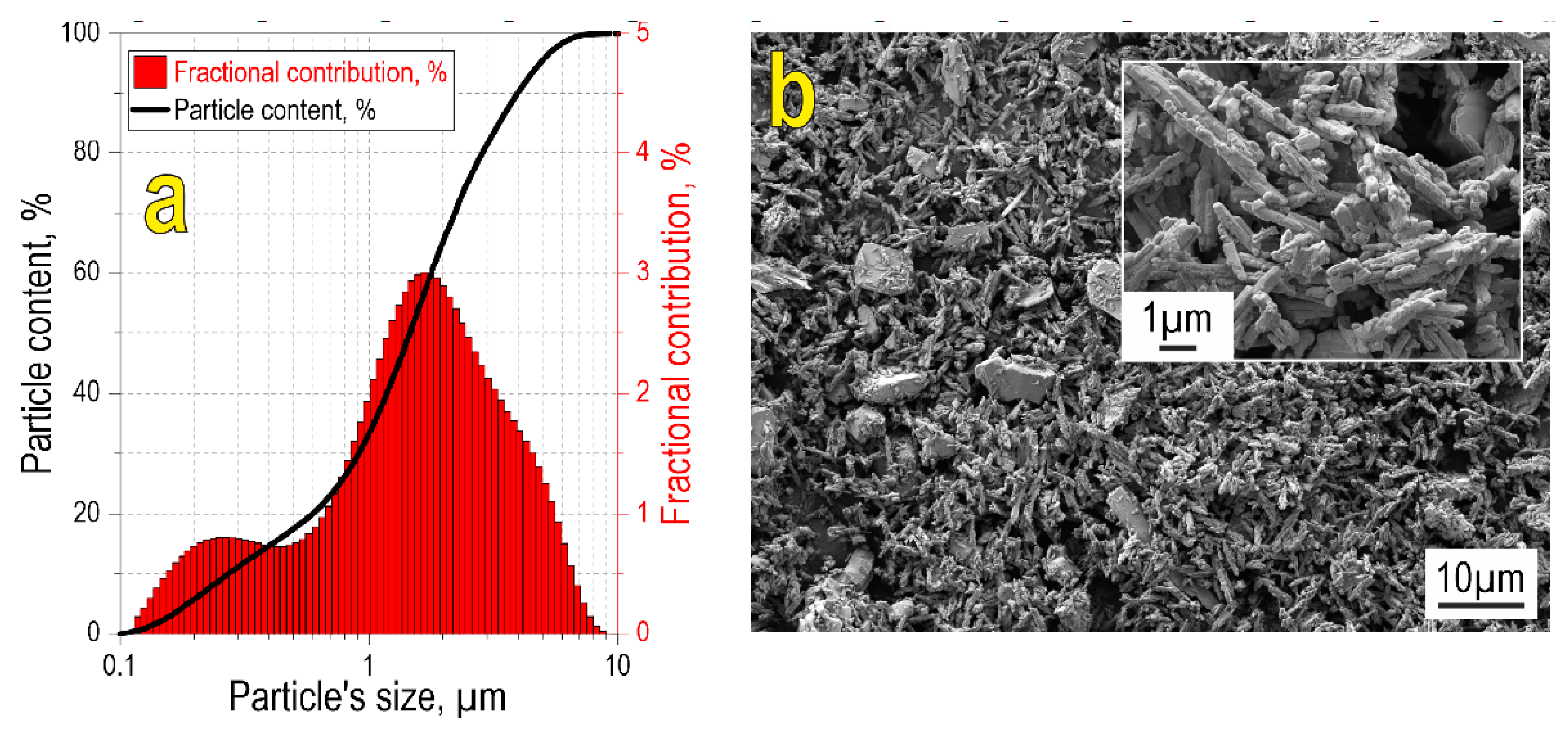


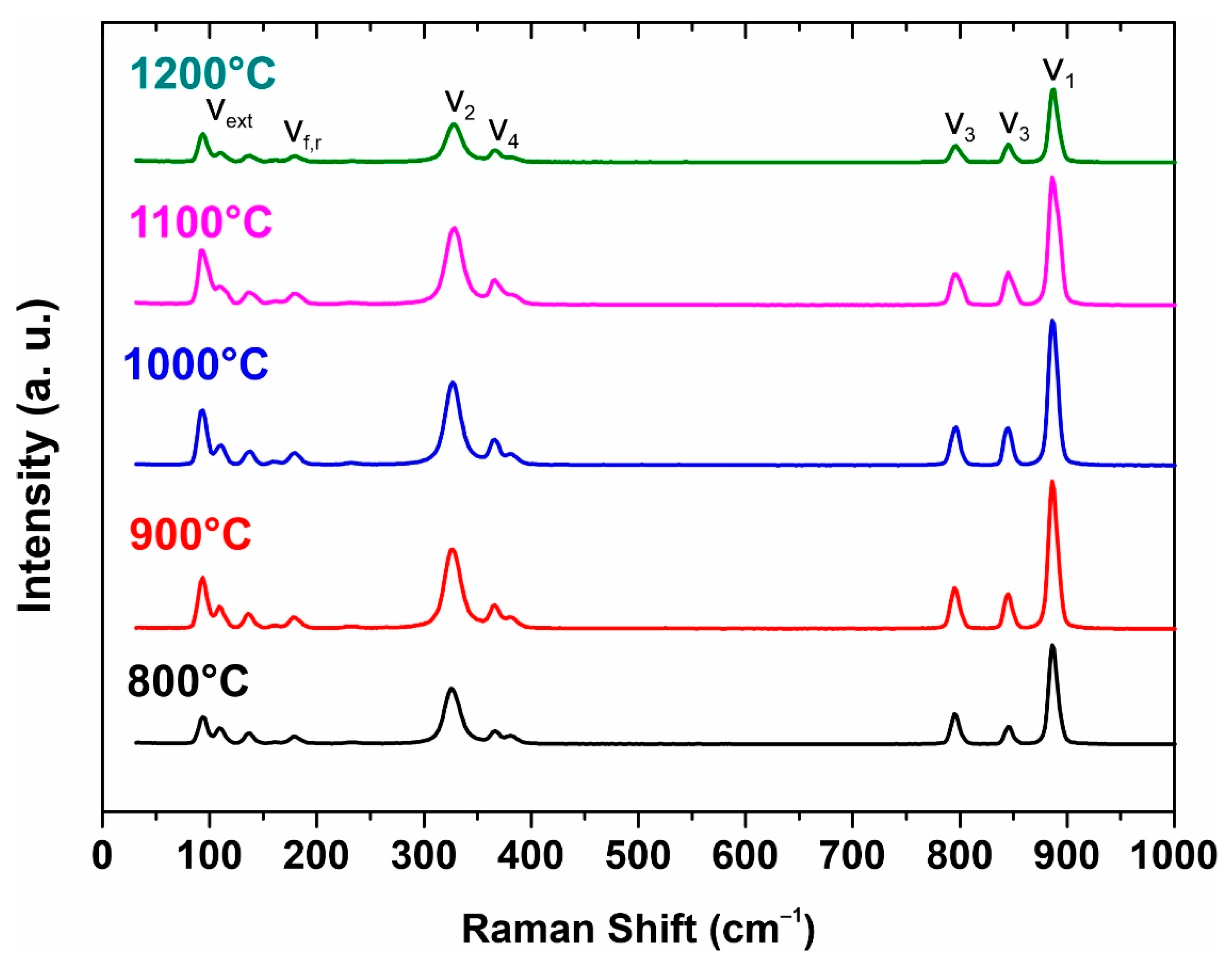
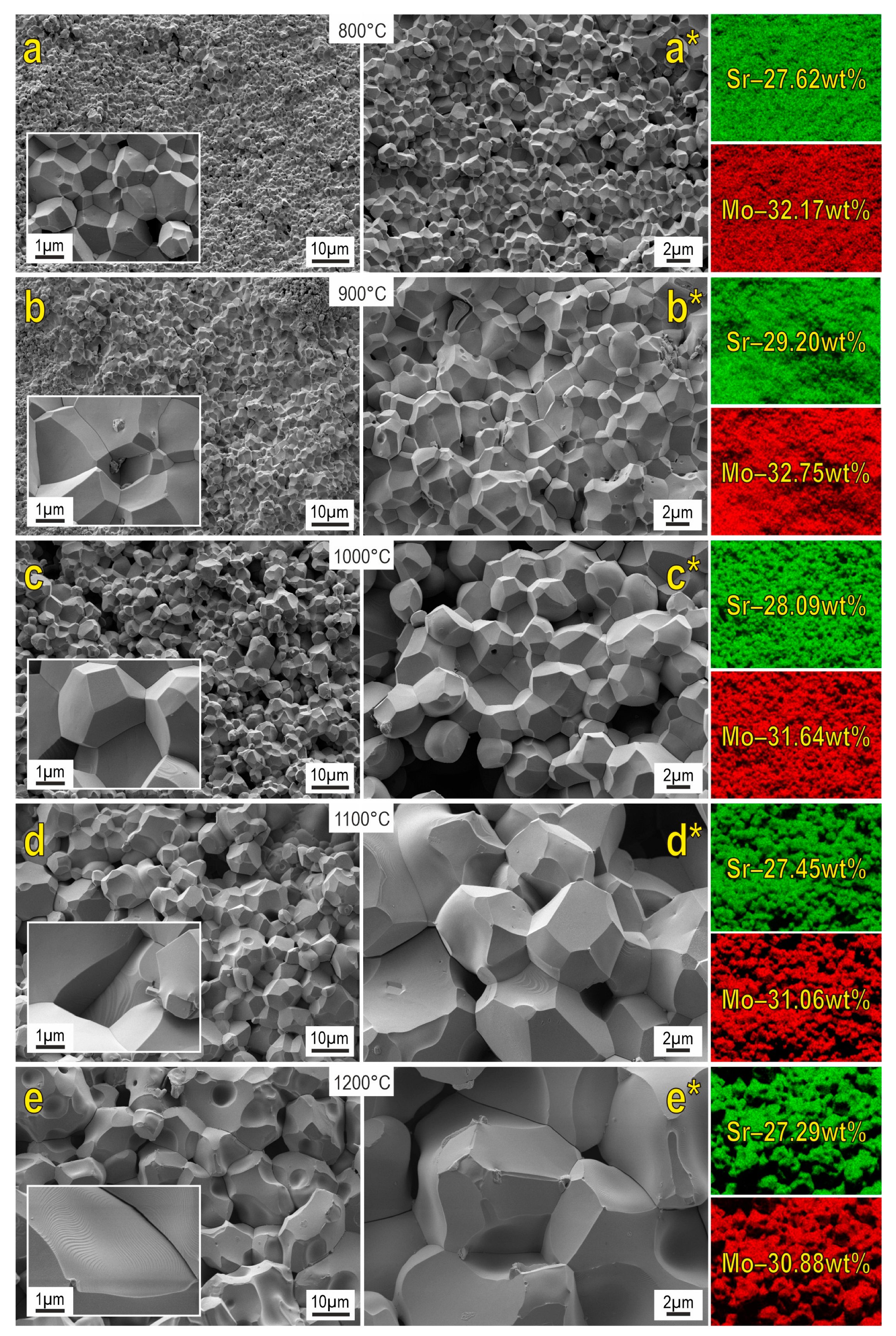
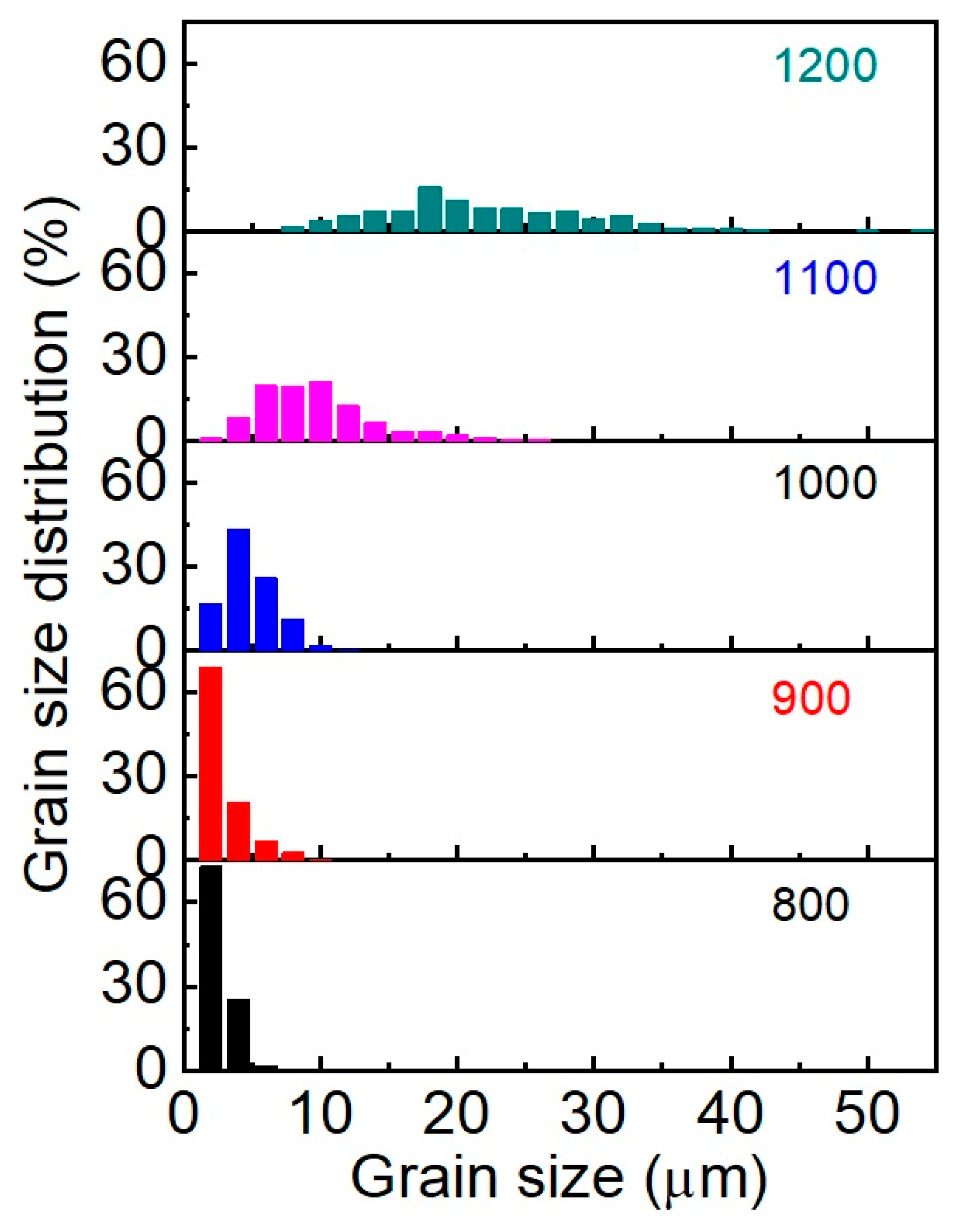
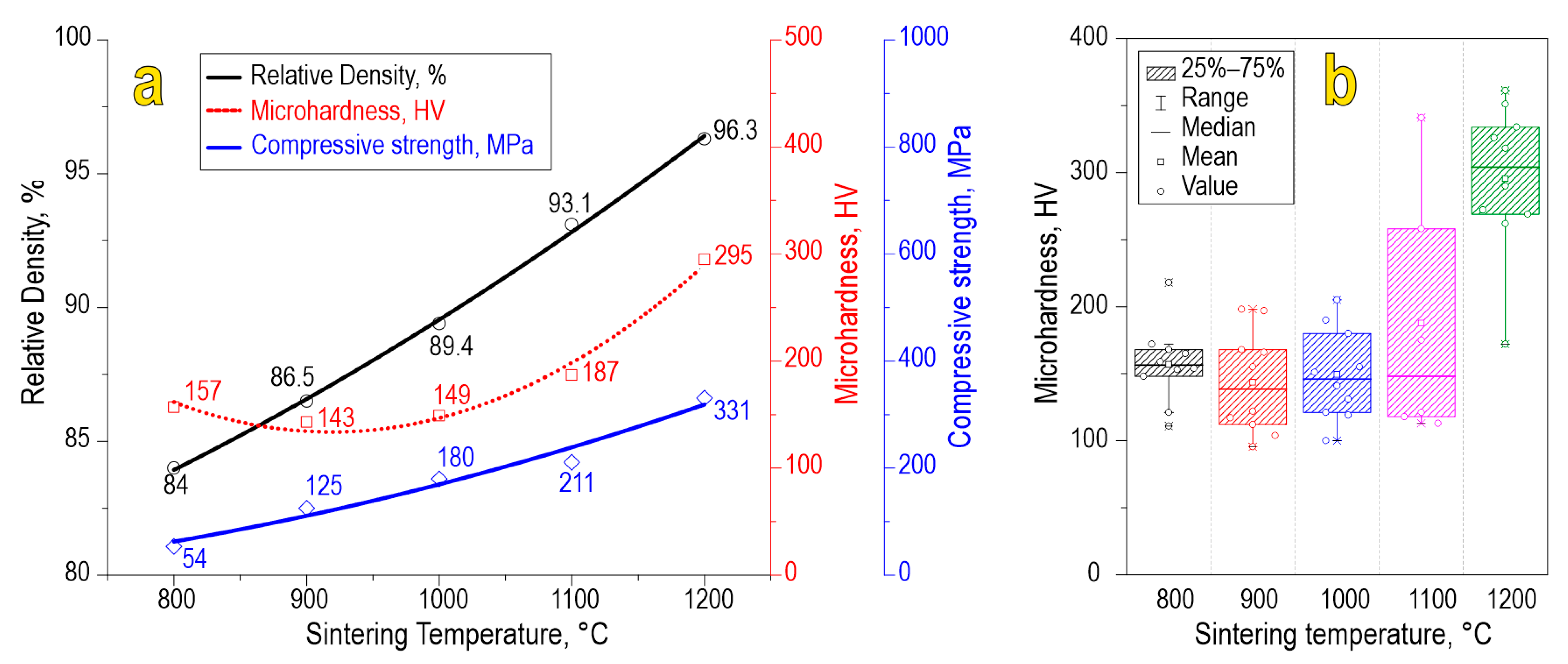

Disclaimer/Publisher’s Note: The statements, opinions and data contained in all publications are solely those of the individual author(s) and contributor(s) and not of MDPI and/or the editor(s). MDPI and/or the editor(s) disclaim responsibility for any injury to people or property resulting from any ideas, methods, instructions or products referred to in the content. |
© 2023 by the authors. Licensee MDPI, Basel, Switzerland. This article is an open access article distributed under the terms and conditions of the Creative Commons Attribution (CC BY) license (https://creativecommons.org/licenses/by/4.0/).
Share and Cite
Belov, A.A.; Shichalin, O.O.; Papynov, E.K.; Buravlev, I.Y.; Portnyagin, A.S.; Azon, S.A.; Fedorets, A.N.; Vornovskikh, A.A.; Kolodeznikov, E.S.; Gridasova, E.A.; et al. An SPS-RS Technique for the Fabrication of SrMoO4 Powellite Mineral-like Ceramics for 90Sr Immobilization. Materials 2023, 16, 5838. https://doi.org/10.3390/ma16175838
Belov AA, Shichalin OO, Papynov EK, Buravlev IY, Portnyagin AS, Azon SA, Fedorets AN, Vornovskikh AA, Kolodeznikov ES, Gridasova EA, et al. An SPS-RS Technique for the Fabrication of SrMoO4 Powellite Mineral-like Ceramics for 90Sr Immobilization. Materials. 2023; 16(17):5838. https://doi.org/10.3390/ma16175838
Chicago/Turabian StyleBelov, Anton A., Oleg O. Shichalin, Evgeniy K. Papynov, Igor Yu. Buravlev, Arseniy S. Portnyagin, Semen A. Azon, Alexander N. Fedorets, Anastasia A. Vornovskikh, Erhan S. Kolodeznikov, Ekaterina A. Gridasova, and et al. 2023. "An SPS-RS Technique for the Fabrication of SrMoO4 Powellite Mineral-like Ceramics for 90Sr Immobilization" Materials 16, no. 17: 5838. https://doi.org/10.3390/ma16175838
APA StyleBelov, A. A., Shichalin, O. O., Papynov, E. K., Buravlev, I. Y., Portnyagin, A. S., Azon, S. A., Fedorets, A. N., Vornovskikh, A. A., Kolodeznikov, E. S., Gridasova, E. A., Pogodaev, A., Kondrikov, N. B., Shi, Y., & Tananaev, I. G. (2023). An SPS-RS Technique for the Fabrication of SrMoO4 Powellite Mineral-like Ceramics for 90Sr Immobilization. Materials, 16(17), 5838. https://doi.org/10.3390/ma16175838









